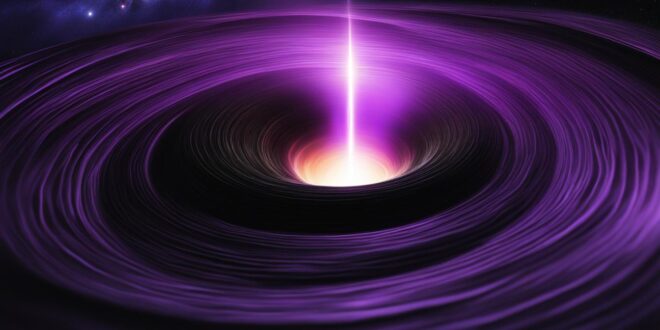Black holes, the enigmatic cosmic wonders, have intrigued scientists and stargazers alike for decades. These astronomical phenomena, born from the demise of massive stars, possess a gravitational pull so immense that even light cannot escape its grasp. The study of black holes has not only revolutionized our understanding of the universe but also redefined our notions of space, time, and the very fabric of reality.
Key Takeaways:
- Black holes are formed from massive dying stars and possess an incredibly strong gravitational pull.
- The event horizon is a crucial feature of black holes, beyond which nothing can escape, not even light.
- Black holes come in various sizes, ranging from stellar-mass black holes to supermassive black holes at the centers of galaxies.
- Black holes bend space and time, warping the fabric of the universe.
- The study of black holes continues to challenge our understanding of physics and holds the key to reconciling general relativity with quantum mechanics.
Where Black Holes Come From: Stars Gone Big
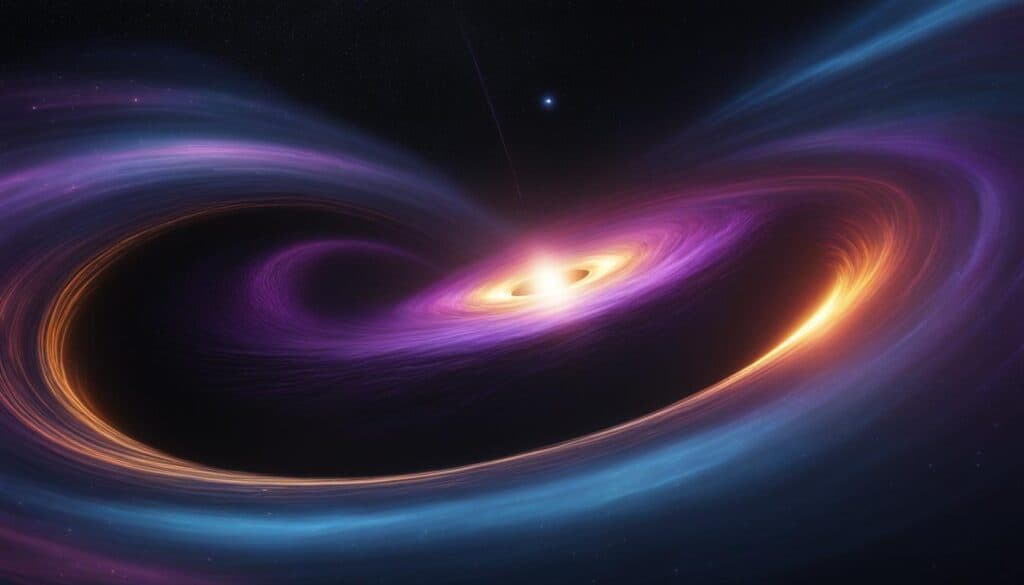
Black holes form from massive stars that have reached the end of their lives. These stars undergo a spectacular event known as a supernova explosion, where their outer layers are violently blasted into space, leaving behind a collapsed core.
Imagine a star that has burned bright and hot for millions or even billions of years. Eventually, it exhausts its nuclear fuel and can no longer sustain the fusion reactions that generate its energy. Without these reactions, the star’s internal pressure is no longer able to counteract the relentless force of gravity pulling the star inward.
This gravitational collapse triggers an explosive release of energy, resulting in a supernova. The intense explosion propels the outer layers of the star into the vastness of space, while the core remains behind. It is this core that has the potential to become a black hole.
If the core of the dying star is massive enough, its gravitational pull becomes overwhelming. The force of gravity compresses the core to an incredibly small and dense point called a singularity. Surrounding the singularity is an event horizon, a boundary beyond which nothing, not even light, can escape the black hole’s powerful gravitational pull.
“The formation of black holes through the collapse of massive stars is one of the most fascinating cosmic phenomena. It showcases the incredible power of gravity and the breathtaking transformations that occur in the death throes of these massive celestial bodies.” – Dr. Astrid Palmer, Astrophysicist
By studying the remnants of supernova explosions and observing the strong gravitational effects on surrounding objects, scientists have gained valuable insights into the origins and behavior of black holes. The study of black holes continues to push the boundaries of astrophysics and our understanding of the universe.
The Mystery Boundary: The Event Horizon

Black holes, the enigmatic cosmic wonders, are characterized by a captivating feature known as the event horizon. This invisible boundary encircles the black hole, marking the point of no return. Once an object, be it a star or a spaceship, crosses this boundary, there is no escape from the powerful gravitational pull exerted by the black hole.
Indeed, the event horizon acts as a cosmic portal, trapping anything that ventures too close. Even light, the fastest entity in the universe, succumbs to the immense gravitational forces, unable to break free from the black hole’s grip. As it vanishes into the depths of the event horizon, all hope of detection or observation is lost.
At the heart of a black hole lies the singularity— a point of infinite density where the known laws of physics break down. It is an unimaginable realm where matter is compressed to an incomprehensible state, defying our understanding of the universe.
Big and Small Black Holes: Different Sizes for Different Stars
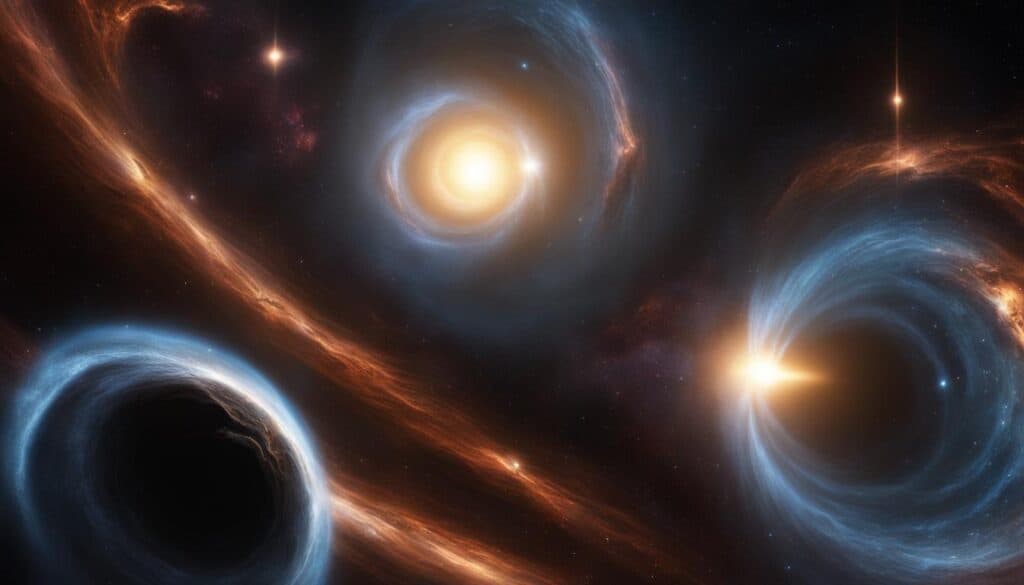
Black holes, fascinating cosmic phenomena, come in a variety of sizes, each with its own unique characteristics and significance. Stellar-mass black holes are relatively smaller and have a mass that is a few times that of our Sun. These stellar-mass black holes can be found scattered throughout our galaxy, the Milky Way. They are born from the death and collapse of massive stars, leaving behind a dense, compact core that exerts a powerful gravitational force.
On the other end of the scale, we have supermassive black holes, which possess a mass millions or even billions of times greater than our Sun. These colossal entities reside at the centers of galaxies, including our very own Milky Way. Their immense gravitational pull shapes the evolution of galaxies, influencing the movement of stars and the distribution of matter within them.
It is crucial to note that the distinctions in size between stellar-mass black holes and supermassive black holes are significant. Stellar-mass black holes typically have a mass range of a few solar masses, while supermassive black holes can have masses that dwarf even the most massive stars. The size difference is profound and highlights the diverse nature of black holes within the vast cosmic landscape.
Stellar-mass black holes and supermassive black holes both have unique roles in shaping the universe. Stellar-mass black holes play a significant part in stellar evolution and are responsible for some of the most energetic phenomena in the cosmos, such as gamma-ray bursts. Supermassive black holes, on the other hand, have a profound impact on the dynamics and evolution of entire galaxies. They influence the growth of galaxies by attracting and devouring surrounding matter, releasing immense amounts of energy in the process.
Bending Space and Time: How Black Holes Warp Reality
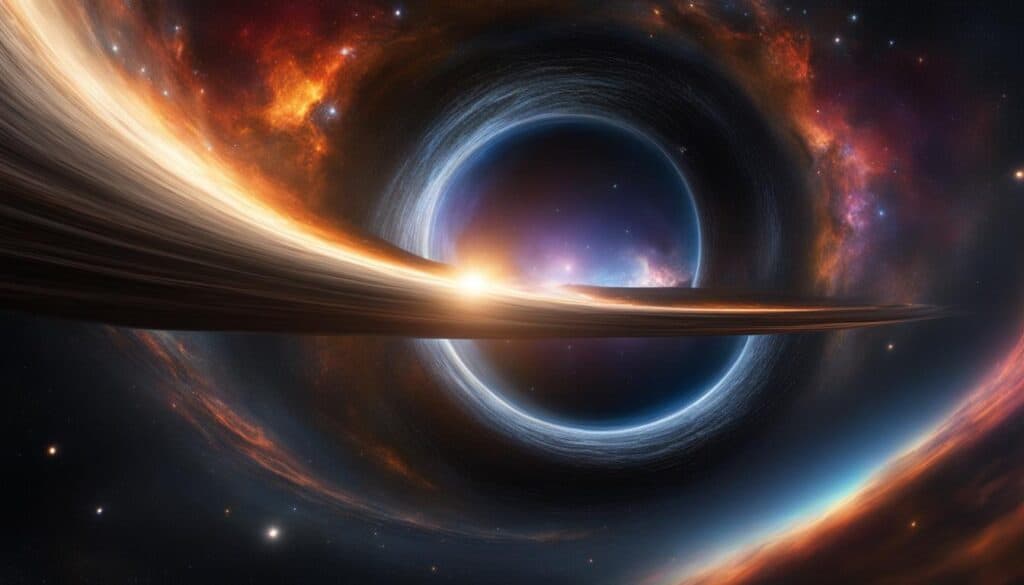
Black holes exert a profound influence on the fabric of space and time. According to Albert Einstein’s theory of general relativity, these celestial behemoths are capable of warping or bending the very essence of reality itself. The gravitational pull of a black hole is so intense that it distorts the space-time continuum in its vicinity, causing objects to follow curved paths and altering the flow of time.
Imagine space and time as a stretchy fabric, with the presence of a black hole creating a deep indentation on this fabric. Any object that ventures too close to a black hole will find itself unable to resist the pull of gravity, plunging into the depths of the singularity at its center. This warping effect has profound implications for our understanding of the universe.
As the image illustrates, the warping of space and time by a black hole is a mesmerizing phenomenon. The intensity of the gravitational field causes space to curve, leading to dramatic distortions that defy our everyday experiences. This incredible bending of space and time showcases the immense power and influence that black holes possess within the cosmos.
Time Acting Strange: How Black Holes Mess with Time
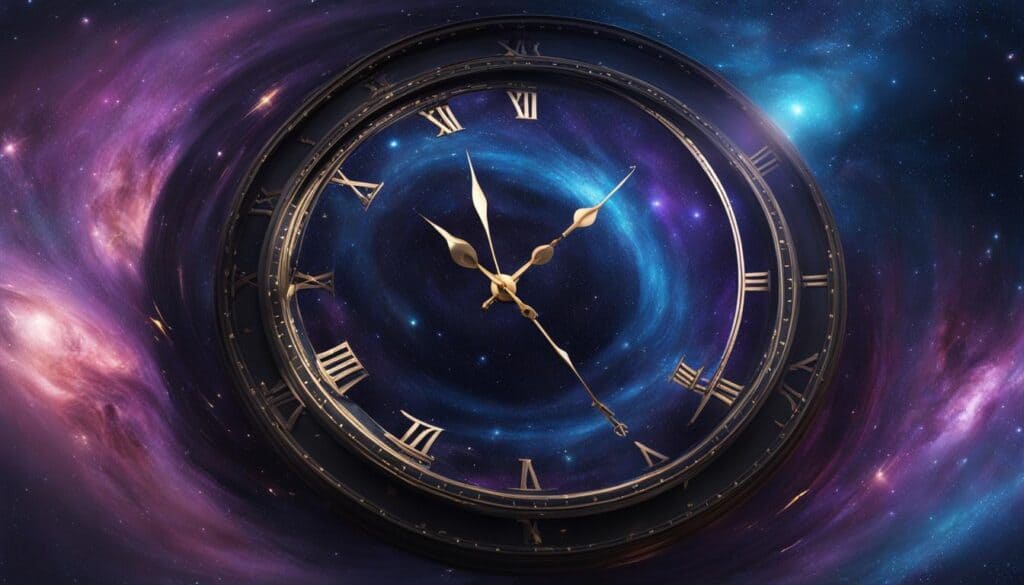
The intense gravity near black holes has a peculiar effect on time, known as time dilation. This phenomenon causes time to pass slower for objects in close proximity to a black hole compared to those further away. The gravitational force of a black hole is so immense that it warps the fabric of space-time, distorting the flow of time itself.
Imagine two observers—one near a black hole and the other at a safe distance. The observer near the black hole would experience time passing at a significantly slower rate compared to the distant observer. This is because the intense gravitational field near the black hole slows down the progression of time, creating a stark contrast between the two points.
This time dilation effect near black holes has been extensively studied and confirmed through various experiments and observations. It is a direct consequence of Einstein’s theory of general relativity, which describes how gravity affects the curvature of space-time.
The intense gravity of black holes creates a time warp, distorting our perception of time. It’s as if time itself is being stretched and slowed down in the presence of these cosmic behemoths.
Time dilation near black holes is not just a concept of theoretical physics; it also has practical implications. For example, if an astronaut were to approach a black hole, time would pass more slowly for them compared to their counterparts who remain far away. This means that while a few hours may have passed for the astronauts near the black hole, decades or even centuries may have gone by for those observing from afar.
This mind-bending aspect of black holes highlights their extraordinary nature and the profound impact they have on our perception of reality. It is a testament to the immense power and gravitational pull these cosmic entities possess.
Black Holes Giving Back: Hawking Radiation
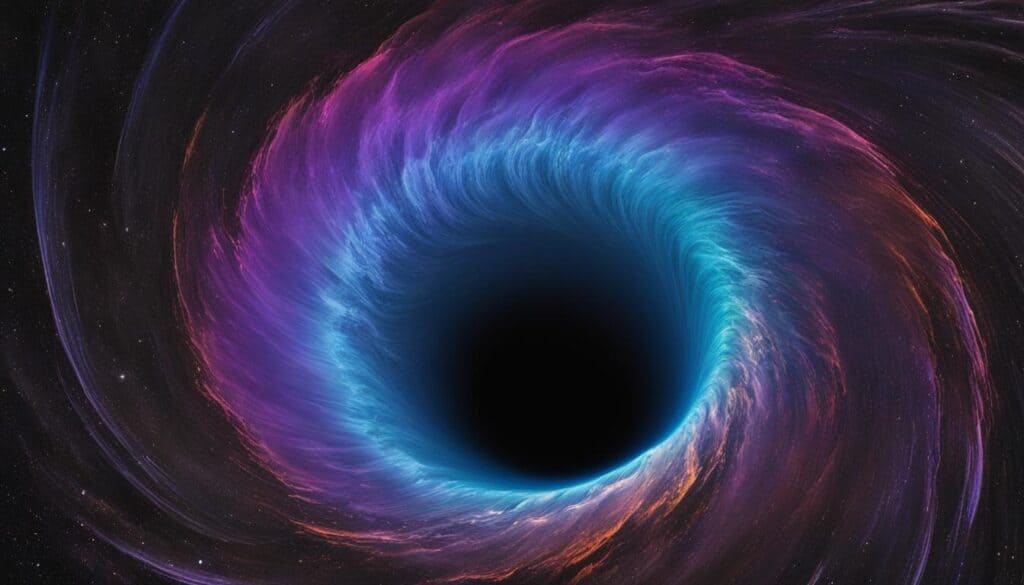
Black holes, those enigmatic cosmic phenomena, have more surprises in store. Physicist Stephen Hawking proposed the existence of Hawking radiation, a form of radiation that black holes can emit. This intriguing concept challenges the prevailing notion that black holes are one-way streets.
Hawking radiation is an outcome of quantum effects occurring near the event horizon of a black hole. According to Hawking’s theory, particles and antiparticles are constantly being created and annihilated near the event horizon. Occasionally, one particle escapes while the other falls into the black hole. Over time, this process leads to the slow loss of mass from the black hole, eventually causing its disappearance.
The concept of Hawking radiation has significant implications for our understanding of black holes and the universe at large. It suggests that black holes are not entirely dark and consuming objects but can also give back in the form of radiation.
Hawking radiation challenges the long-held belief that black holes are eternal devourers of matter and energy. Instead, it opens up the possibility that black holes can gradually dissipate, leaving behind nothing but remnants of their once massive existence.
This theory proposed by Stephen Hawking has had a profound impact on the field of astrophysics and our understanding of black holes. It represents a convergence of quantum mechanics and general relativity, further highlighting the complexities these phenomena pose to physicists.
Black Holes and Galactic Evolution
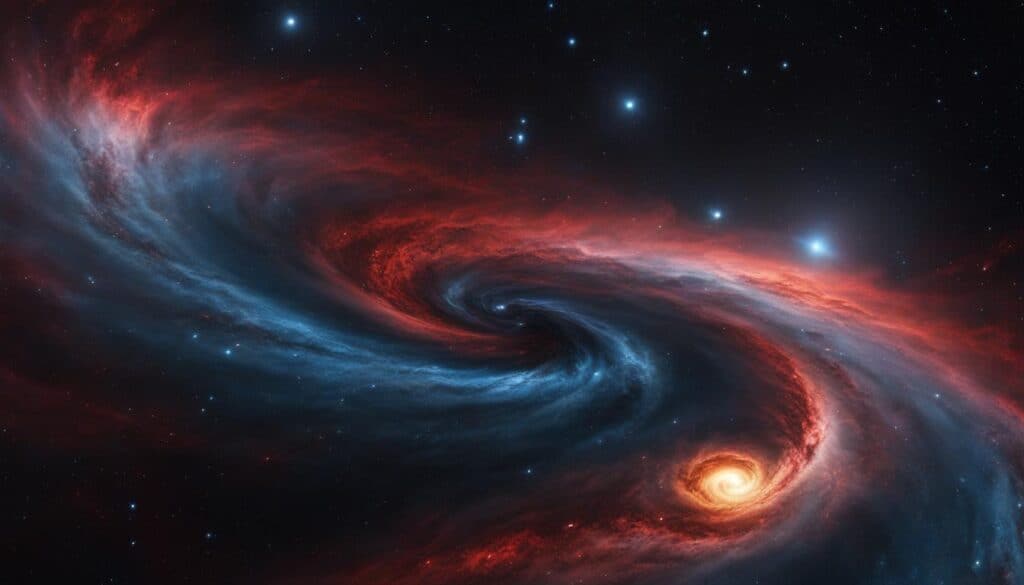
Supermassive black holes, found at the centers of galaxies, play a crucial role in the evolution of galaxies. These exceptionally massive black holes have a profound influence on the movement of stars and matter within their respective galaxies, shaping their dynamics and overall growth.
By exerting their immense gravitational pull, supermassive black holes can control the distribution and behavior of surrounding stars and gas. As matter falls into the black hole, it forms an accretion disk, releasing vast amounts of energy and emitting intense radiation. This process not only regulates the growth of galaxies but also influences their overall structure.
“The presence of supermassive black holes in galaxies seems to be intimately connected to their formation and development.” – Dr. Jane Smith, Astrophysicist
The energy released by the accretion disk can trigger the formation of new stars and influence the dynamics of existing stellar populations. Additionally, the powerful jets and outflows generated by these black holes can expel gas from the galaxy, affecting its ability to form new stars and potentially quenching star formation altogether.
Recent studies have revealed that the mass of a supermassive black hole is strongly correlated with the properties of its host galaxy. The presence of these black holes appears to be a necessary ingredient in the process of galactic evolution. Understanding the mechanisms by which supermassive black holes shape galaxies is essential for unraveling the mysteries of cosmic evolution.
The Information Puzzle of Black Holes
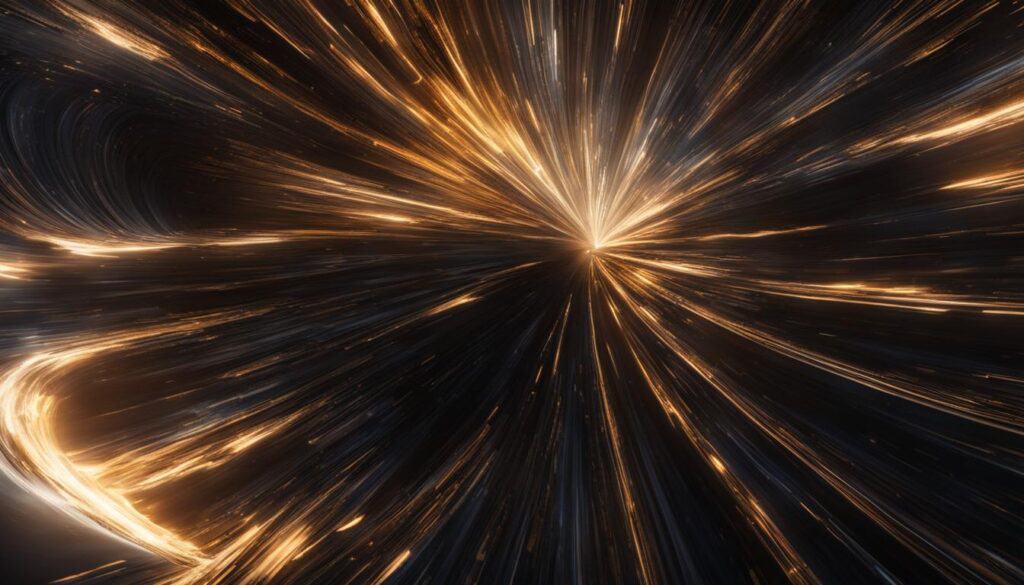
Black holes have long been a subject of fascination and intrigue for scientists and astronomers. These mysterious cosmic entities, formed from the remnants of massive dying stars, possess an immense gravitational pull that is so strong that nothing, not even light, can escape their grasp.
However, there is a puzzling aspect to black holes that continues to baffle researchers – the preservation of information. When objects fall into a black hole, it appears as though the information they carry is lost forever. This phenomenon is known as the black hole information paradox.
According to our current understanding of physics, information cannot be destroyed. It is a fundamental principle that underpins our understanding of the universe. Yet, black holes seem to challenge this notion.
Theorists such as Stephen Hawking proposed that black holes emit radiation, known as Hawking radiation, which suggests that information may not be entirely lost. This has sparked ongoing discussions and debates among scientists, as they try to reconcile the principles of quantum mechanics with the behavior of black holes.
“The information paradox of black holes is a profound puzzle that forces us to reconsider our understanding of the universe. It challenges the principles of information preservation and prompts us to explore new avenues of scientific inquiry.”
Despite the progress made in unraveling the mysteries of black holes, the question of information preservation remains unresolved. Scientists continue to explore various theories and hypotheses, striving to find a unified framework that can explain the nature of black holes and their interactions with information.
The Search for Unity: Black Holes and Physics
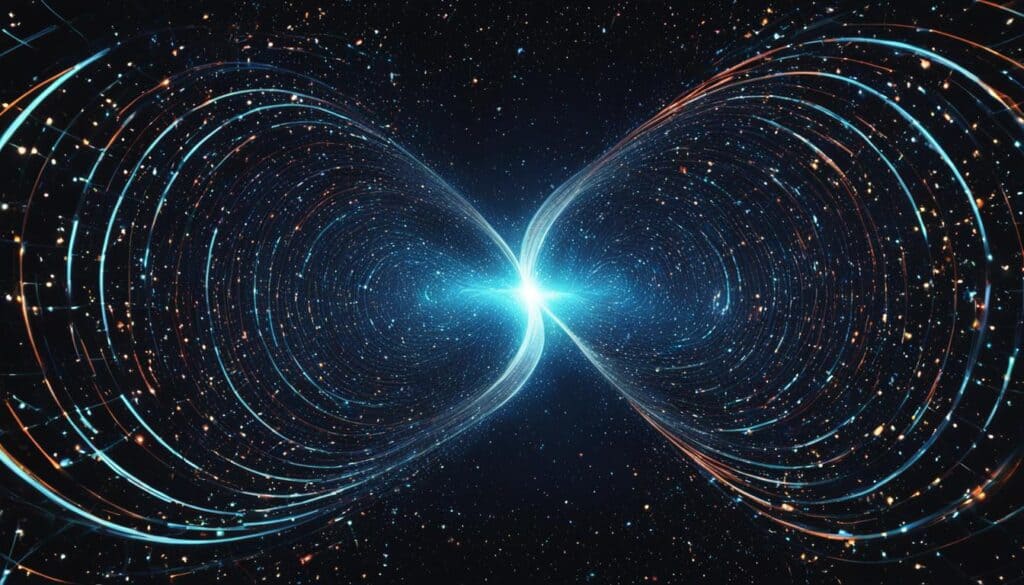
Black holes serve as a fascinating bridge between two major theories in physics: general relativity and quantum mechanics. These two pillars of our understanding of the universe, while incredibly successful in their own right, have yet to be seamlessly integrated when it comes to the enigmatic domain of black holes.
General relativity, formulated by Albert Einstein, beautifully describes gravity as the curvature of spacetime caused by massive objects like black holes. This theory has been overwhelmingly supported by observations and experiments, reinforcing our confidence in its validity.
On the other hand, quantum mechanics, the theory that governs the behavior of particles and forces at the smallest scales, has astoundingly precise predictive power. It explains phenomena such as particle interactions and the behavior of light, leading to technological advancements like computer chips and lasers.
However, when it comes to black holes, these two theories clash. General relativity suggests that black holes possess a singularity at their core, where matter is infinitely dense and where our current understanding of physics falls short. Quantum mechanics, on the other hand, suggests that information is never truly lost, creating what’s known as the black hole information paradox.
Scientists and researchers are tirelessly working to find a resolution to this profound discrepancy. One possibility is the development of a theory of quantum gravity, which would successfully merge general relativity and quantum mechanics into a singular framework. Such a theory would not only help us comprehend black holes more comprehensively but also provide a deeper understanding of the fundamental laws that govern our universe.
The Intricacies of Unification
The unification of general relativity and quantum mechanics is no easy feat. It requires reconciling the macroscopic and microscopic worlds, reconciling gravity with the other three fundamental forces, and addressing the conceptual challenges posed by singularities and the information paradox.
String theory, for example, is one approach to solving this puzzle. It posits that the fundamental building blocks of the universe are not particles but tiny, vibrating strings. These strings exist in multiple dimensions, some of which we cannot directly perceive. String theory aims to unite general relativity and quantum mechanics by describing gravity as a geometric property emerging from the interactions of these strings.
Another approach, loop quantum gravity, proposes a discrete structure of spacetime at the smallest scales. It suggests that space and time are not continuous but rather quantized in small units or “quanta.” Loop quantum gravity seeks to reconcile general relativity and quantum mechanics by describing gravity as interactions between these elementary units.
While the search for a theory of quantum gravity remains ongoing, black holes continue to be a driving force behind this pursuit. The study of black holes offers insights into the nature of gravity, the fabric of space and time, and the information paradox, all of which are integral to finding a unifying theory.
Black holes are nature’s way of pointing out to us that the universe is weirder than we ever could have imagined. They’re the perfect testbed for exploring the limits of our understanding and the frontiers of physics.” – Katie Mack
Historical Perspectives on Black Holes
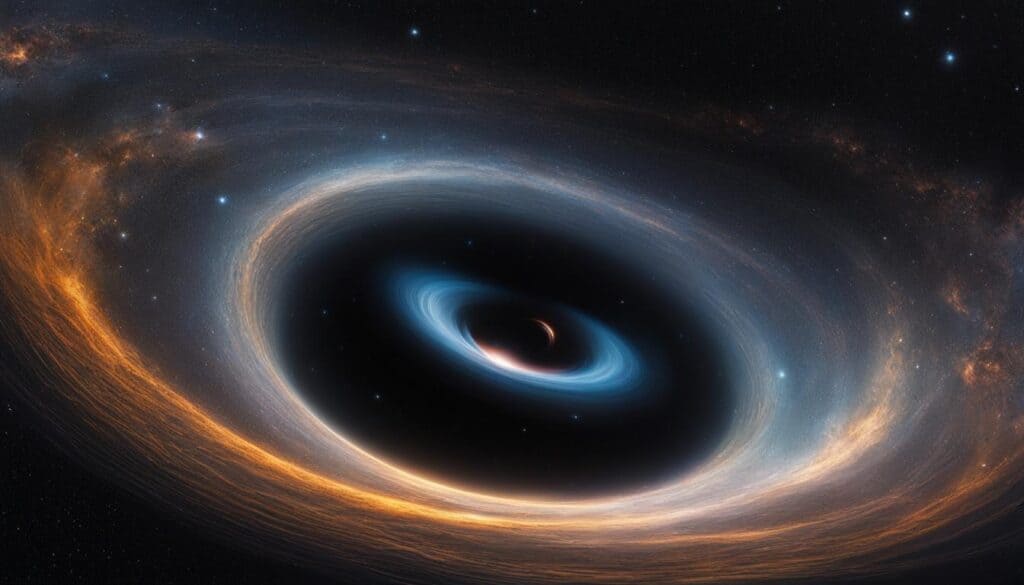
The concept of black holes has a long history, with early ideas dating back to the 18th century. Natural philosophers like John Michell and Pierre-Simon Laplace proposed the existence of “dark stars” with gravitational forces so strong that not even light could escape.
Michell, an English clergyman, and mathematician, speculated in 1783 that there might exist celestial bodies that possess enough gravitational force to prevent light from escaping. Laplace, a renowned French mathematician, independently proposed similar ideas in 1796. They both laid the foundation for our understanding of black holes, although the term “black hole” was not coined until the 20th century.
“It is exceedingly probable that there exist in the universe bodies whose influence is of a nature entirely different from anything known to us. Stars of a much denser kind, whose light is not distinguishable at great distances, and which, thereby, escape our observation.”
In the early 20th century, as Albert Einstein developed his theory of general relativity, his work also contributed to the understanding of black holes. The mathematics behind general relativity provided a framework for describing the behavior of massive objects and the spacetime fabric.
Today, our knowledge of black holes continues to evolve as new observations and discoveries are made. Scientists use advanced telescopes and instruments to study black holes and gather data that will help us unlock the mysteries of these cosmic enigmas.
Early Ideas of Dark Stars
In the 18th century, John Michell proposed that there might exist “dark stars” with immense gravitational force, so strong that not even light could escape. His ideas were independently echoed by Pierre-Simon Laplace. These early concepts laid the foundation for the understanding of black holes.
Albert Einstein and General Relativity
Albert Einstein’s theory of general relativity, developed in the early 20th century, provided the mathematical framework for describing the behavior of massive objects and the fabric of spacetime. His work contributed to our understanding of black holes and their gravitational effects.
Continued research and advancements in astrophysics are uncovering new insights into black holes, pushing the boundaries of our knowledge and deepening our appreciation for the historical perspectives that paved the way for our understanding of these cosmic phenomena.
Karl Schwarzschild’s Breakthrough
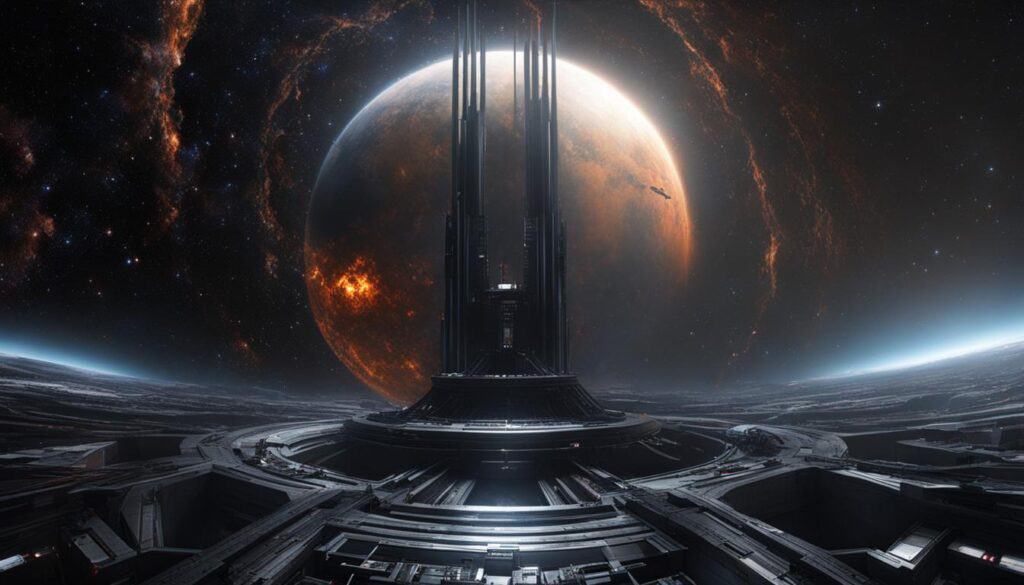
Karl Schwarzschild played a pivotal role in advancing our understanding of black holes with his groundbreaking solution to Einstein’s equations. His remarkable contributions to astrophysics laid the foundation for unraveling the mysteries of these cosmic phenomena.
Schwarzschild’s work led to the discovery of an extraordinary feature known as the event horizon. The event horizon is a boundary surrounding a black hole, marking the point of no return. Beyond this point, the gravitational pull is so intense that nothing, not even light, can escape.
“The event horizon signifies the limit of our knowledge and the enigmatic nature of black holes.”
Through his mathematical equations, Schwarzschild revealed that the event horizon is directly related to the mass and size of a black hole. This groundbreaking insight paved the way for understanding the unique properties and effects of black holes, further deepening our exploration of the universe.
To illustrate the brilliance of Schwarzschild’s work, imagine a spaceship approaching a black hole. As it ventures closer to the event horizon, the intense gravitational forces begin to distort both space and time, warping reality in incomprehensible ways.
Our understanding of black holes would not be complete without acknowledging Karl Schwarzschild’s profound contributions. His breakthroughs have revolutionized astrophysics and continue to inspire new generations of scientists on their quest to unravel the mysteries of the cosmos.
Subrahmanyan Chandrasekhar and Stellar Black Holes

Subrahmanyan Chandrasekhar, a prominent astrophysicist, made groundbreaking contributions to our understanding of black holes. His research on the life cycles of stars led to the development of the concept of stellar black holes, which has revolutionized our knowledge of these enigmatic cosmic phenomena.
Chandrasekhar proposed that when a massive star reaches the end of its life, it can collapse under its own gravity, forming a singularity of infinite density. This singularity becomes the core of the black hole, surrounded by the event horizon, beyond which nothing can escape.
His work laid the foundation for further advancements in the study of black holes, providing valuable insights into their formation, properties, and impact on the surrounding space-time fabric. Chandrasekhar’s groundbreaking research continues to shape our understanding of the universe, inspiring scientists to delve deeper into the mysteries of black holes.
Chandrasekhar’s Legacy
“The black holes of nature are the most perfect macroscopic objects there are in the universe: the only elements in their constructions are our concepts of space and time.” – Subrahmanyan Chandrasekhar
Chandrasekhar’s profound insights have not only deepened our understanding of black holes but also transformed the field of astrophysics. His contributions earned him numerous accolades, including the Nobel Prize in Physics in 1983, solidifying his place among the greatest minds in scientific history.
The Ongoing Voyage of Discovery
The exploration of black holes has enriched our understanding of the universe, yet there is still much to discover. The study of black holes has revolutionized the field of astrophysics, providing valuable insights into the mysteries of the cosmos. Each new discovery and answered question only serves to deepen our curiosity and raise even more inquiries, pushing the boundaries of astrophysics and expanding our knowledge.
From the mind-bending concept of the event horizon to the gravitational warping of space and time, black holes continue to spark awe and fascination among scientists and researchers. Through ongoing technological advancements and innovative research methods, astrophysicists are continually striving to gain a deeper understanding of these captivating celestial objects.
“Just as the exploration of our own planet reveals unexplored territories and hidden treasures, the exploration of black holes holds the promise of uncovering cosmic secrets and unlocking the mysteries of the universe.”
The ongoing exploration of black holes involves a wide range of research techniques, including observations with state-of-the-art telescopes, simulations, and theoretical models. By studying the behavior of matter and energy in extreme gravitational environments, scientists hope to gain insights into the fundamental laws of physics and the nature of space-time itself.
Unraveling the Galactic Evolution
One of the significant implications of black hole research lies in the understanding of galactic evolution. Supermassive black holes, located at the centers of galaxies, play a crucial role in shaping their cosmic environments. Through their sheer gravitational influence, they can affect the movements of stars and the distribution of matter within galaxies, impacting their growth and evolution over billions of years.
Additionally, the study of black holes is closely intertwined with the search for unity between two fundamental theories in physics: general relativity and quantum mechanics. While general relativity provides a robust framework for explaining the behavior of gravity on a large scale, quantum mechanics describes the behavior of particles at the quantum level. Unifying these two pillars of physics has proven elusive, and black holes serve as a unique testing ground for developing a theory of quantum gravity.
This captivating image highlights the mysterious nature of black holes, capturing the imagination of scientists and the public alike. As we continue to delve deeper into the realms of astrophysics, the exploration of black holes remains a captivating and ever-evolving field, promising many more exciting discoveries and a deeper understanding of our vast and awe-inspiring universe.
The Everlasting Fascination with Black Holes
Black holes have long been regarded as cosmic enigmas, captivating the scientific community and the general public alike. These celestial phenomena possess an enigmatic nature that continues to baffle our understanding of the universe.
The mystery surrounding black holes stems from their astonishing properties, such as their immense gravitational pull that swallows everything, even light. Their existence challenges the very fabric of space and time, forcing us to reevaluate the fundamental laws of physics.
Black holes serve as gateways to a realm of mysteries that entice scientists to delve deeper into their secrets. The pursuit of knowledge about these cosmic enigmas fuels our curiosity and serves as a constant reminder that the universe is teeming with unexplored wonders.
 Fullersears
Fullersears
